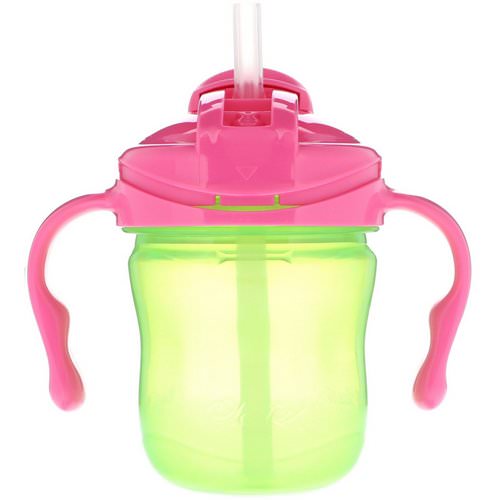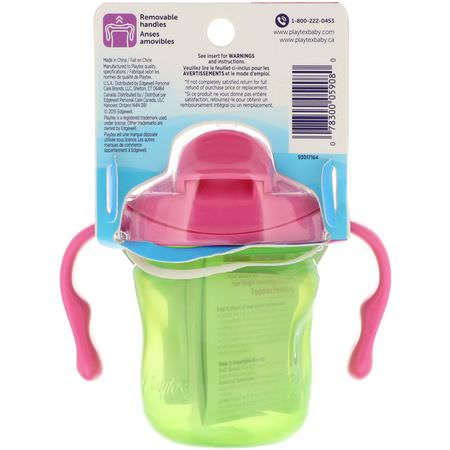Foodpharmacy Blog: Kids, Baby, Kids Feeding, Cups
Playtex Baby, Sipsters, Training Cup, 4+ Months, 1 Cup, 6 oz (177 ml)

$3.70
Product name: Playtex Baby, Sipsters, Training Cup, 4+ Months, 1 Cup, 6 oz (177 ml)
Quantity: 1 Count, 0.08 kg, 12.2 x 16.8 x 8.1 cm
Categories: Playtex Baby, Baby, Kids, Kids Feeding, Cups, Bpa Free
Spill-Proof Straw, Training Cup, Leak-Proof 100%, Removable Handles, BPA Free, For over 20 years, parents have counted on Playtex for high quality, spill-proof cups that help make toddler feeding fun and hassle-free.

They look more like toys for your baby, so he can have so much fun while learning to drink with them. So as to manage and control the cups easy handles are provided on the either side of the cups. The american speech-language-hearing association recommends that parents make a pop-up straw cup as children to transition to using normal adult cups. There have been cases when a manufacturer has recalled cups due to the formation of molds in the internal valve of the cup. There are some tried and true sippy cup alternatives that you can successfully introduce to your baby. They are designed for children 6-months of age or older and therefore have a harder bite resistant spout than many comparable cups. So why would you want to consider letting your child use a leak-proof cup? Learner cups are ideal for children who are 4-months old up to 12-months old. My pick for the best sippy cup for 6 month old breastfed baby? With this in mind, there is also a lesser chance that your child may get properly hydrated when they are spilling their drink all the time. Whichever you feel is safest for your child, the lid will fit nicely on top with it’s stretchable silicone material.
Playtex Baby, Sipsters, Training Cup, 4+ Months, 1 Cup, 6 oz (177 ml): Cups, Kids Feeding, Kids, Baby
Make the transition from breastfeeding simple for your baby with zolibot sippy cup! For babies, the cups catered to them are usually 5 to 6 ounces while the cups catered to toddlers are usually 9 to 12 ounces. As a result, most bottles and sippy cups are made from plastic and silicone materials. This sippy cup is bpa-free and safe for your child to use. Sippy cups are one of the cheapest purchases for your child, so there is no worries about buying the wrong cup. We would not recommend something that we would not use ourselves, and in the end, our choices reflect what we would, and have, purchased for our children. This munchkin sippy cup combines the best of both features available in 360 cups and in insulated sippy cups. Recommended for babies and toddlers, the lid is carefully threaded to ensure there are no milk spills when your kid is using it.

These cups are accurately described above. I am a graduate of the university of southern california and have studied newborn baby care at the university of colorado. So, given the popularity of leak-proof cups, and their ability to keep children hydrated in a mess-free manner, what should parents do? One of the best ways to minimize your carbon footprint and raise a more earth-friendly baby is to reuse things you already have. In this case, try feeding baby breastmilk with a spoon, dropper or syringe. As is the case with many products designed for children, the sippy cup was brought into existence by a frustrated parent looking to solve a problem. There are many reasons why you would choose to start at 6 months including your schedule, not having enough breast milk anymore, nipple irritation, a fussy baby that never took to suckling, your baby is getting in teeth, and you just want to have a choice not to breastfeed.
Although these sippy cups are quite heavy for toddlers to pick up, they certainly will not shatter, break or chip. The philips website writes that dentists recommend the short straw for exercising mouth muscles, so it might be better for an older baby who has had more practice. It is this feature of adjustment that makes this cup so attractive because it allows parents to use the cup for children as young as 6 months and as old as four or five years old. Tip the cup upwards slightly to make the milk flow into his mouth, and then slowly leave your grip to let your baby drink on his own. The best brands provide cups that are leak proof, spill proof, and break proof. Babies naturally prefer bottles to cups since drinking from a bottle is convenient and similar to drinking from a breast. Straws and spoutless cups are designed to avoid those risks. A first stage sippy cup will come with a soft spout for drinking, which gives the child the feel of a bottle or nipple, while still inducing them to make a sucking motion to drink.
A lot of the purchases you have to make for your baby are serious. Whether or not you continue to nurse throughout the toddler years, pediatricians recommend weaning your baby from the bottle (Of breastmilk or formula) and switching to a cup at approximately 12 months old in order to support oral appropriate oral motor skill development. While steel cups are heavier than plastic, the options in this review have design features that make them easier to hold like the narrow neck on the klean kanteen. Even with this minor flaw, however, this cup should still be looked at closely by parents looking for a cup for their 12-month or older child. See here for a more complete list of eco-food and beverage storage containers. Look for glass cups with silicone sleeves to make them less slippery and more shatterproof. Since transition cups are a little more tricky to handle than your standard toddler sippy cup, my recommendation is for the oxo transition spout.
Playtex Baby Cups
Grip-friendly baby spoons and baby mugs with spouts and 2 large handles for your child, as well as feeding spoons with long handles for you. Parents should always keep in mind the age and progress of their child as this could be very helpful in picking out a cup. She is an avid home cook who has whiled away thousands of hours cooking and obsessively researching all things related to food and food science. Most babies are ready to start drinking from something other than a baby bottle around the age of 6-9 months, although some show no interest before 12 months of age. Pura has got a lot of good press for the recyclable, plastic-free design, and we do like that you can keep milk cold in this bottle for much longer than any of the other cups. Made from food-grade stainless steel (18/8), The pura kiki straw bottle is another great choice for parents looking for non-toxic sippy cup alternatives. Our daughter graduated from the standard sippy cups, which she enjoyed flipping upside down and beating against the table until she soaked the table in sticky apple juice on a daily basis.
If you want a slightly larger cup for your young one, i recommend buying these cups over the other ones. The unique design of a bottle is to provide the necessary feeding tool for your child to use while also having the extrusion reflex. I did not want to connect it to the chest strap as that created an obstacle for him to around to get food into his mouth. What you pick for your kid is subjective and depends on personal preferences. Therefore, there are a few features that parents should consider when buying a baby cup. The cups can hold up to 8 ounces of liquid. Transition sippy cups can help babies feel independent and keep parents free of messes related to spills.
I would give a child a sippy cup at 5-6 months, just for practice, and get serious about teaching them how to suck and drink from it between 10-12 months. The nhs says that using an open cup or a free-flow cup without a valve will help your baby learn to sip rather than suck, which is better for their teeth, but it may be more practical on some occasions to choose a different cup. Some even argue that using a sippy can delay a child’s desire or ability to master ordinary cup usage. As the name suggests, these are sippy cups with inserted straw in place of a spout. Sippy cups vary in a whole lot of ways, you have sippy cups with straw, spill proof ones, eco-friendly ones and a lot more. The munchkin miracle 360 is a favorite for both parents and kids alike, with a spoutless design that allows for drinking from anywhere along the outer edge. As soon as your child starts sitting it is a time for a transition to sippy cup from a normal feeding bottle. While it may seem impossible, drinking from a cup is a developmental milestone that your baby will achieve between ten and 12 months of age. That said, phthalates tend to be found in soft plastic (Think bath toys), so most sippy cups are probably in the clear. These silicone cups make a great toddler learning cup.
My boys love the superhero graphics and want to use these cups all the time. Certified bpa-free and dishwasher-safe, the parts of these cups are even interchangeable with the blue my penguin sippy cups. On the flip side, these cups are really less of a transition than a stop-gap. The sippy cups come in packs of two at a great value. For the active toddler who never slows down, this 4,1 star camelbak eddy kids 12 oz water bottle may be just the thing they need to stay perfectly hydrated throughout the day. Suitable for use from four months to age three, each of the colourful cups holds up to 50ml and can be used for drinks, purees or even expressed breast milk. This nuby is probably ideal for kids just making the transition to a sippy cup but the quality is really very nice for such an affordable cup. For the same price i could buy each of the nuby cups described above and have a transition cup and a toddler cup. Like the assortment of names, there are a wide variety of baby cups to suit different ages and preferences. Straw cups without valves are also good for thicker liquids like smoothies or shakes, making this a more versatile option than some of the competition.
Introduce the new cup when your baby is hungry but not in a fussy mood. Holding, lifting, and tipping her own cup to drink is an important part of the learning process for your baby. Your child should not use a sippy cup beyond 24 months and by this age should have transitioned completely to drinking from an open cup. Tip: You can start serving water with meals starting at 6 months, or whenever baby starts solids in consultation with your pediatrician. This also lets children control the flow of liquid themselves.